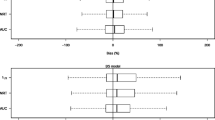Abstract
Purpose. Based on real data, to evaluate the usefulness of taking into account samples with values below the limit of quantification (LOQ) for the evaluation of pharmacokinetic studies.
Methods. To compare for two drugs, after single dose administration the pharmacokinetic parameters obtained by using a poorly sensitive assay (PSA) and a highly sensitive assay (HSA), acting as reference; To evaluate the results of pharmacokinetic studies in the light of different values for the LOQ.
Results. Under certain conditions, such as homogeneous population, sufficient subject number, sufficient sampling times and acceptable accuracy (CV < 20%) for the concentrations, it is possible to get valuable and more reliable kinetic information by using concentrations obtained with a poor precision (CV > 20%). This is especially true for the parameters associated with the terminal phase, such as t1/2β and AUC, but also for parameters depending to a lesser extent on the terminal phase, such as tl/2α and AUCtn. Moreover, the mean concentration time curve is by far best defined by using all the concentrations.
Conclusions. In some situations, it is preferable to use concentrations with values below the LOQ to evaluate the results of pharmacokinetic studies. However, this should not be the rule, especially when this does not bring any additional information, or when it is possible to increase the sensitivity of the bioanalytical assay.
Access this article
We’re sorry, something doesn't seem to be working properly.
Please try refreshing the page. If that doesn't work, please contact support so we can address the problem.
Similar content being viewed by others
REFERENCES
A. B. J. Nix, D. W. Wilson. Assay detection limits: concept, definition and estimation. Eur. J. Clin. Pharmacol 39:203–206 (1990).
V. P. Shah, K. K. Midha, S. Dighe, I. J. McGilveray, J. P. Skelly, A. Yacobi, T. Layloff, C. T. Viswanathan, C. E. Cook, R. D. McDowall, K. A. Pittman, S. Spector. Analytical methods validation: bioavailability, bioequivalence and pharmacokinetic studies. Eur. J. Drug Metab. 16:249–255 (1991).
J. O. Westgard, P. L. Barry. Cost effective quality control: managing the quality and productivity of analytical processes, AACC Press, Washington DC, 1986, pp. 33–64.
A. J. Jackson. Inappropriate inclusion of non-quantifiable plasma concentrations in the estimation of extent of absorption. Biopharm. Drug Disp. 13:629–634 (1992).
P. Francheteau, J. L. Steimer, C. Dubray, D. Lavène. Mathematical model for in vivo pharmacodynamics integrating fluctuation to the response: application to the prolactin suppressant effect of the dopaminomimetic drug DCN 203–922. J. of Pharm. and Biopharm. 19(3):287 (1991).
H. Zehender, M. D. Cabiac, J. Denouël, J. Faergemann, P. Donastsch, K. Kutz, H. Humbert. Elimination kinetics of terbinafine (lamisil) from human plasma and tissues following multiple dose administration of 250 mg daily during four, twelve and fourty-eight weeks and comparison with three main metabolites. Drug Invest. 8(4):203–210 (1994).
D. A. Graves. Failure of single dose kinetics to predict steady-state. Drug Intell. Clin. Pharm. 22:917–918 (1988).
H. T. Karnes, G. Shiu, V. P. Shah. Validation of bioanalytical methods. Pharm. Res. 8:421–426 (1991).
W. A. Sadler, M. H. Smith. Use and abuse of imprecision profiles: some pitfalls illustrated by computing and plotting confidence intervals. Clin. Chem. 36:1346–1350 (1990).
M. Gibaldi, D. Perrier. Pharmacokinetics, 2nd edition, Marcel Dekker Inc, New-York, 1983.
L. B. Sheiner. ELSFITT (Version 3.1). A program for the extended least Squares fit to individual pharmacokinetic data. Users manual. April 1985. Technical report of the division of Clinical Pharmacology, University of California, San Francisco, CA 94143, USA.
D. A. Graves, C. S. Locke, Jr., K. T. Muir, R. P. Miller. The influence of assay variability on pharmacokinetic parameter estimation. J. Pharmacokin. Biopharm. 17:571–592, 1989.
H. Passing, W. Bablok. A new biometrical procedure for testing the equality of measurements from two different analytical methods. Application of linear regression procedures for method comparison studies in clinical chemistry. Part I. J. Clin. Chem. Clin. Biochem. 21:709–720, 1983.
F. Y. Bois, T. N. Tozer, W. W. Hauck, M. L. Chen, R. Patnaik, R. L. Williams. Bioequivalence: performance of several measures of extent of absorption. Pharm. Research 11(5):715 (1994).
S. E. Tett, D. J. Cutler. Apparent dose-dependence of chloroquine pharmacokinetics due to limited assay sensitivity and short sampling times. Eur. J. Clin. Pharmacol. 31:729–731 (1987).
Author information
Authors and Affiliations
Rights and permissions
About this article
Cite this article
Humbert, H., Cabiac, M.D., Barradas, J. et al. Evaluation of Pharmacokinetic Studies: Is It Useful to Take into Account Concentrations Below the Limit of Quantification?. Pharm Res 13, 839–845 (1996). https://doi.org/10.1023/A:1016088609005
Issue Date:
DOI: https://doi.org/10.1023/A:1016088609005




